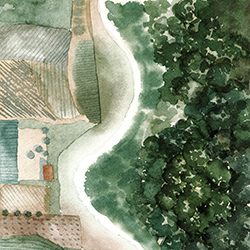
Threshold Landscapes. New cartography of places in transition
Salome Katamadze
Landscape scholarship 2020/2021
Subject area Theories and policies for landscape
tutors: Simonetta Zanon, head of Landscape projects area; Luigi Latini, chairman of the Scientific Committee of Fondazione Benetton
The research aims to review the complex role of the border from the point of view of the Landscape. This element of separation can be read not only as an abstract line but as a threshold with its depth, with a marginality of exchange and contamination, a space between things that cannot be captured in the graphical abstraction of a simple two-dimensional representation.
To determine the esthetics and characteristics of these marginal spaces it is necessary to elaborate a language that goes far beyond the disciplinary limits, in fact, the study composes a Trans-Disciplinary framework, based on the thoughts, experiences, and works of figures from various fields. From these premises, the research introduces a concept of Threshold Landscapes, to inquire about the places contaminated with the cultural, social, or natural exchange in their condition of discontinuity between different identities.
The reason for the difficulty in identifying the Threshold Landscapes lies in their transience, elusive to the signs of modern cartography and the perception of the world generated via quantitative parameters and topographical discretization. As much as the aspect of transition is one of the main qualities of the Threshold Landscapes, it causes indistinguishability in the perception of the community, which leads to a neglected attitude toward these places. For this reason, the ultimate aim of the research is to reevaluate the richness of Threshold Landscapes, currently ignored within collective memory. Examination of Landscape practices and representation tools allows to elaborate new keys towards site reading, reestablish additional values or rediscover the old ones of the marginal places.
Salome Katamadze, born in Tbilisi (Georgia), begins her university studies in 2012 at the National Academy of Fine Arts in Tbilisi, after winning two ministerial merit scholarships. The following year she wins a scholarship from the Technical University of Kaunas, Lithuania, and moves to the department of Civil Engineering and Architecture.
In 2015 she wins an Erasmus+ scholarship, at the Department of Architecture of the University of Ferrara, where she continues his studies until graduating her Master’s Degree in Architecture in 2020.
The thesis “Inhabitation as an act of defining the Border”, developed in the laboratory of Landscape Architecture and Infrastructure, deals with the relationship between landscape and border through the study case of the Caucasus Mountains between Georgia and the Russia.
Since 2017, she has been teaching assistant in design studios, developing research about politics and anthropic space. She has participated in numerous exhibitions at the University of Ferrara, Iuav University of Venice, III biennial of Architecture in Pisa and the Macro – Museum of Contemporary Art in Rome. In parallel with her academic career, she has gained professional experience in the local architectural firms. In 2020 she founds Noia Practice, a research studio in which she investigates the role of landscape in defining the identity of places.
Dida foto
Times and ridges. An Investigation of the representation of Montello ridge as a Threshold element, which contains different landscape identities of the territory. The ridge is the place where the intensity and frequency of experience is greatest and most kinetic (Watercolor on paper, drawing by Salome Katamadze)
